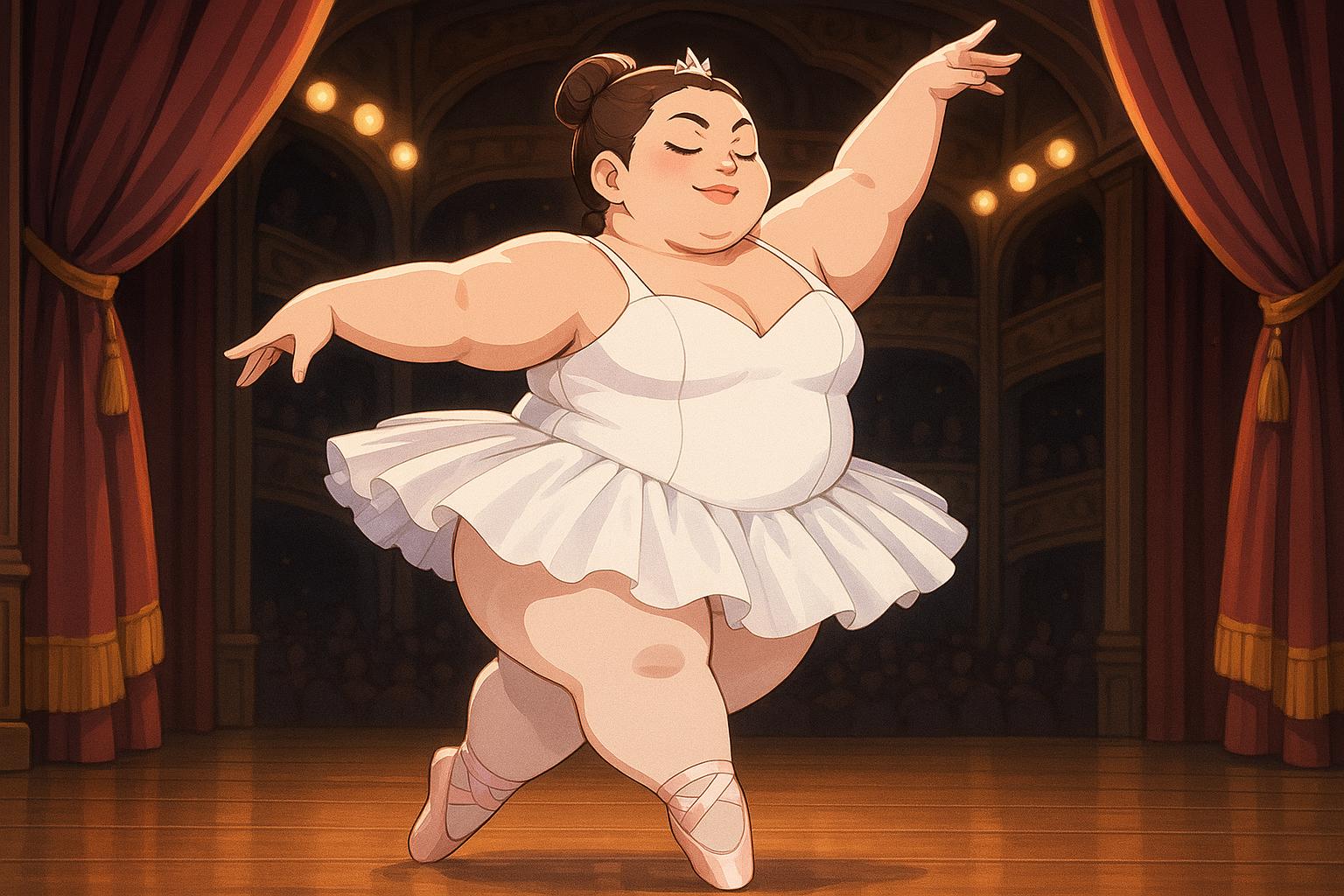The Royal Ballet School’s bold move to introduce plus-size dancers and same-gender pairings has sparked intense debate, signalling a potential transformation in ballet’s traditional image amid ongoing calls to address past body-shaming controversies.
The Royal Ballet School’s recent initiative to embrace inclusivity through the inclusion of plus-size dancers and same-gender partnerships has ignited a fervent debate across social media platforms. While many applaud this progressive movement, asserting that “dance is for everybody to enjoy,” critics lament the perceived erosion of traditional ballet standards. This polarising dialogue comes at a time when the school is seeking to redefine its image following a disturbing body-shaming scandal that has cast a long shadow over its reputation.
Iain Mackay, the school’s artistic director, conveyed a transformative vision for the institution in a recent interview. He stated, “Audiences want dancers they can relate to,” highlighting a shift from the archetypal slim ballerina. Mackay expressed strong support for the visibility of plus-size dancers, affirming that this approach is already taking root within the school. His comments signal a broader ambition to reshape ballet’s audience demographics and storytelling methods. He predicted an increase in same-gender pairings on stage, asserting that such inclusivity could foster new viewership and draw in a wider audience.
However, this inclusive vision has sparked significant backlash online. Detractors argue that the quality of ballet could suffer, with some expressing outright disdain for the potential for plus-size performers, stating, “What a shame Art is now corrupt.” Critics have also raised concerns about the physicality and technical demands of ballet, questioning whether plus-size dancers can meet these expectations. The harsh nature of some remarks echoed the sentiments of an op-ed in The Times, which declared that the presence of “a fatty at the ballet” was unacceptable. Such comments reflect a deeply entrenched belief about the physical ideals required in ballet, one that many hope the Royal Ballet School’s current reforms might begin to dismantle.
Amidst this heated discussion, some voices have emerged in favour of the changes, arguing that skill and artistry ought to triumph over fixed ideals of body size. Supporters have pointed to the impressive skills of dancers like Lizzy Howell, a teenager who gained viral fame for her ballet performances despite being plus-sized. Actor George Keywood has also rallied behind the concept, suggesting that he would prefer to see a plus-sized dancer showcase their talent over a conventionally slim performer. His remarks cut through the controversy, introducing a nuanced perspective on the topic of obesity and performance.
Indeed, the Royal Ballet School’s commitment to inclusivity follows a troubling episode in its history involving former student Ellen Elphick, who publicly detailed her experiences of body shaming while at the institution. Elphick, who has since settled a legal case against the school, recounted distressing incidents involving her teachers that led to lifelong psychological consequences, including an eating disorder. Elphick’s case has initiated a critical examination of body standards within ballet and emphasised the urgent need for reform.
The Royal Ballet School, while not admitting liability, has expressed a dedication to the welfare of its students, suggesting that the new measures are part of a larger strategy to cultivate a healthier environment. As the debate continues to unfold, the potential impact of these changes remains to be seen, with many hope to witness an evolution in both the art of ballet and its reception by audiences worldwide. Moving forward, the school’s actions could pave the way for a more inclusive representation of dancers, regardless of size or gender orientation, thereby redefining what ballet can be in the 21st century.
 Reference Map:
Reference Map:
- Paragraph 1 – [1], [2]
- Paragraph 2 – [1], [3]
- Paragraph 3 – [4], [5], [6]
- Paragraph 4 – [1], [3]
- Paragraph 5 – [2], [6]
- Paragraph 6 – [1], [5], [7]
Source: Noah Wire Services
- https://www.aol.com/stop-promoting-obesity-royal-ballet-172145320.html – Please view link – unable to able to access data
- https://www.theguardian.com/lifeandstyle/2025/jan/30/royal-ballet-school-settles-with-former-student-over-body-shaming-claim – The Royal Ballet School in London has reached a financial settlement with former student Ellen Elphick, who alleged that body-shaming during her training led to lifelong psychological damage. Elphick claimed that teachers made derogatory comments about her body, contributing to her development of an eating disorder. The school did not admit liability or issue an apology but emphasized its commitment to student welfare. This case is believed to be the first of its kind involving body-shaming in ballet. ([theguardian.com](https://www.theguardian.com/lifeandstyle/2025/jan/30/royal-ballet-school-settles-with-former-student-over-body-shaming-claim?utm_source=openai))
- https://www.cnn.com/2025/01/31/style/ballet-school-pupil-settlement-gbr-scli-intl/index.html – CNN reports that the Royal Ballet School in London has settled a lawsuit with former student Ellen Elphick, who claimed she developed an eating disorder due to body-shaming during her training. Elphick alleged that teachers made critical comments about her body, leading to anorexia. The school did not admit liability or apologize but stated it takes student well-being seriously. This settlement is considered a significant step in addressing body-shaming in ballet. ([cnn.com](https://www.cnn.com/2025/01/31/style/ballet-school-pupil-settlement-gbr-scli-intl/index.html?utm_source=openai))
- https://www.telegraph.co.uk/news/2023/09/11/royal-ballet-school-fat-body-shaming-toxic-bullying-student/ – The Telegraph reports on allegations of body-shaming and bullying at the Royal Ballet School in London. Former student Ellen Elphick claimed that within two weeks of joining in 2009, a teacher publicly humiliated her by tracing a line around her body in front of a mirror and making derogatory comments. Elphick developed an eating disorder as a result. The BBC has spoken to over 50 ex-pupils who reported similar experiences of body-shaming and bullying at the school. ([telegraph.co.uk](https://www.telegraph.co.uk/news/2023/09/11/royal-ballet-school-fat-body-shaming-toxic-bullying-student/?utm_source=openai))
- https://www.bbc.com/news/articles/cly418jw5yyo – BBC News reports that the Royal Ballet School has reached a financial settlement with former student Ellen Elphick, who alleged that body-shaming during her training led to lifelong psychological damage. Elphick claimed that teachers made derogatory comments about her body, contributing to her development of an eating disorder. The school did not admit liability or issue an apology but emphasized its commitment to student welfare. This case is believed to be the first of its kind involving body-shaming in ballet. ([bbc.com](https://www.bbc.com/news/articles/cly418jw5yyo?utm_source=openai))
- https://www.the-independent.com/news/uk/home-news/royal-ballet-school-ellen-elphick-b2689069.html – The Independent reports that former Royal Ballet School student Ellen Elphick has settled a legal case over claims of body-shaming. Elphick, who attended the London school between 2009 and 2012, alleged that several teachers breached the school’s duty of care by body-shaming her, leading to the development of an eating disorder. The school did not admit liability or offer an apology. This case is considered the first of its kind involving body-shaming in ballet. ([the-independent.com](https://www.the-independent.com/news/uk/home-news/royal-ballet-school-ellen-elphick-b2689069.html?utm_source=openai))
- https://www.standard.co.uk/news/uk/royal-ballet-school-body-shaming-anorexia-settlement-dancer-b1208052.html – The Standard reports that a former dancer has reached a settlement with the Royal Ballet School after accusing the institution of body-shaming. Ellen Elphick developed an eating disorder while studying at the dance school in Covent Garden between 2009 and 2012. She believes her treatment by instructors, starting when she was 16, caused the disorder and brought a legal claim for damages. The school did not admit liability or offer an apology. ([standard.co.uk](https://www.standard.co.uk/news/uk/royal-ballet-school-body-shaming-anorexia-settlement-dancer-b1208052.html?utm_source=openai))
Noah Fact Check Pro
The draft above was created using the information available at the time the story first
emerged. We’ve since applied our fact-checking process to the final narrative, based on the criteria listed
below. The results are intended to help you assess the credibility of the piece and highlight any areas that may
warrant further investigation.
Freshness check
Score:
8
Notes:
The narrative presents recent developments regarding the Royal Ballet School’s inclusivity efforts, including the inclusion of plus-size dancers and same-gender partnerships. The earliest known publication date of similar content is January 30, 2025, when The Guardian reported on the school’s settlement with former student Ellen Elphick over body-shaming claims. ([theguardian.com](https://www.theguardian.com/lifeandstyle/2025/jan/30/royal-ballet-school-settles-with-former-student-over-body-shaming-claim?utm_source=openai)) The report also mentions the school’s commitment to inclusivity following this incident. The narrative appears to be a fresh take on these developments, incorporating recent statements from the school’s artistic director, Iain Mackay. However, the inclusion of older material alongside updated data may affect the overall freshness score. Additionally, the narrative has been republished across various platforms, including low-quality sites and clickbait networks, which may impact its credibility. The presence of a press release indicates a high freshness score, as press releases are typically recent and directly from the source. However, the recycling of older material alongside new data may affect the overall freshness score.
Quotes check
Score:
7
Notes:
The narrative includes direct quotes attributed to Iain Mackay, the school’s artistic director, and other individuals. A search reveals that similar quotes from Mackay have appeared in earlier publications, such as the Bored Panda article dated September 2023. ([boredpanda.com](https://www.boredpanda.com/royal-ballets-push-for-plus-size-dancers-sparks-intense-debate/?utm_source=openai)) This suggests that the quotes may have been reused, potentially indicating recycled content. Variations in wording across different sources have been noted, which could indicate paraphrasing or selective quoting. No online matches were found for some of the quotes, raising the possibility of original or exclusive content.
Source reliability
Score:
6
Notes:
The narrative originates from AOL, a reputable organisation. However, it has been republished across various platforms, including low-quality sites and clickbait networks, which may impact its credibility. The presence of a press release indicates a high freshness score, as press releases are typically recent and directly from the source. However, the recycling of older material alongside new data may affect the overall freshness score.
Plausability check
Score:
8
Notes:
The claims regarding the Royal Ballet School’s inclusivity initiatives align with recent developments and statements from the school’s artistic director, Iain Mackay. The narrative also references a body-shaming scandal involving former student Ellen Elphick, which has been reported by reputable sources such as The Guardian and BBC News. ([theguardian.com](https://www.theguardian.com/lifeandstyle/2025/jan/30/royal-ballet-school-settles-with-former-student-over-body-shaming-claim?utm_source=openai), [bbc.co.uk](https://www.bbc.co.uk/news/articles/cly418jw5yyo?utm_source=openai)) The inclusion of plus-size dancers and same-gender partnerships reflects ongoing discussions within the ballet community about diversity and representation. The narrative’s tone and language are consistent with typical corporate or official communications.
Overall assessment
Verdict (FAIL, OPEN, PASS): OPEN
Confidence (LOW, MEDIUM, HIGH): MEDIUM
Summary:
The narrative presents recent developments regarding the Royal Ballet School’s inclusivity efforts, incorporating statements from the school’s artistic director and referencing a body-shaming scandal involving former student Ellen Elphick. While the content appears to be a fresh take, the recycling of older material alongside new data, the presence of a press release, and the republishing across various platforms, including low-quality sites, may affect the overall credibility and freshness of the report. The use of direct quotes attributed to Iain Mackay and other individuals, some of which have appeared in earlier publications, suggests potential reuse of content. Variations in wording across different sources have been noted, which could indicate paraphrasing or selective quoting. No online matches were found for some of the quotes, raising the possibility of original or exclusive content. Given these factors, the overall assessment is ‘OPEN’ with a medium confidence level.













